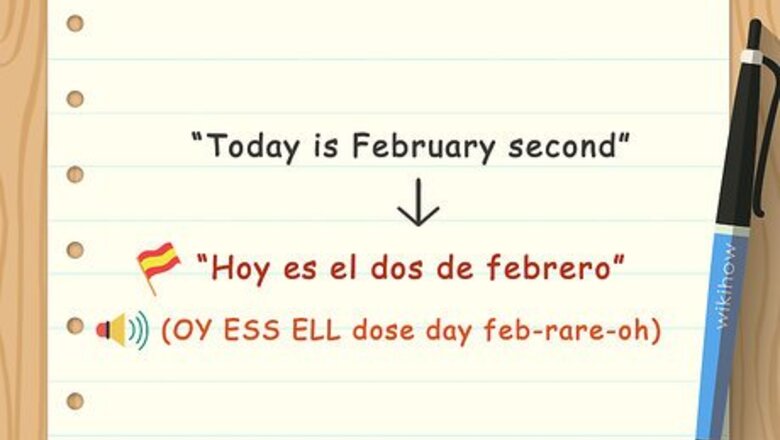
views
X
Research source
Saying the Date
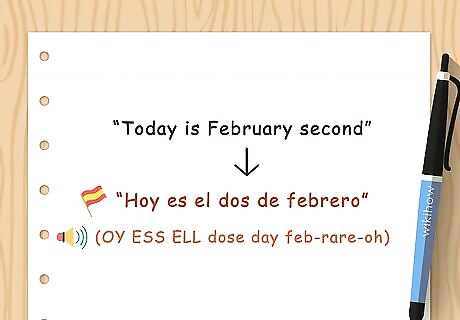
Use the formula "El numéro de mes." When someone asks you the date in Spanish, you'll always follow the same formula. Start with el (ELL), followed by the number that corresponds to the day. Then say de (DAY) followed by the name of the month. You can start by saying hoy es (OY ESS) before the date, which means "today is." For example, if someone asked you the date, you could say "Hoy es el dos de febrero," or "Today is February second." In most contexts it is also acceptable simply to say the date.
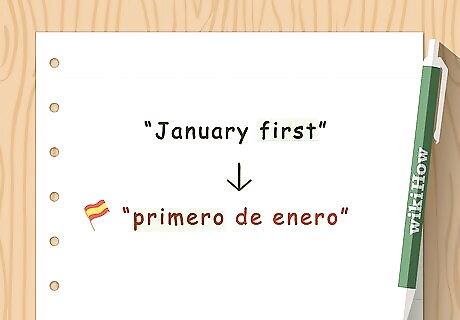
Start with the number of the day. In English, ordinals (such as "second" or "third") are often used to say the date. In Spanish, however, you always just use the number. To say the date in Spanish you'll need to know the words for all the numbers from one to 31. There is one exception to this rule. When you are talking about the first of the month in Spanish, you use the word primero, which means "first." If you aren't yet comfortable with your numbers, practice counting in Spanish. You can also post notes around your house with the numeral and the Spanish word for that number so you get used to associating the two.

Pronounce the month correctly. After saying the day, you'll add the word de (DAY) and then say the month of the year. If you don't already have the months of the year in Spanish memorized, buy a Spanish calendar so you're looking at them regularly. January is enero (ay-NAIR-oh). February is febrero (fay-BRAY-roh). March is marzo (MAR-soh). April is abril (AH-breel). May is mayo (MY-oh). June is junio (HOO-nee-oh). July is julio (HOO-lee-oh). August is agosto (ah-GOHS-toh). September is septiembre (sayp-tee-AIM-bray). October is octubre (ahk-TOO-bray). November is noviembre (noh-bee-AIM-bray). December is diciembre (dee-see-AIM-bray).
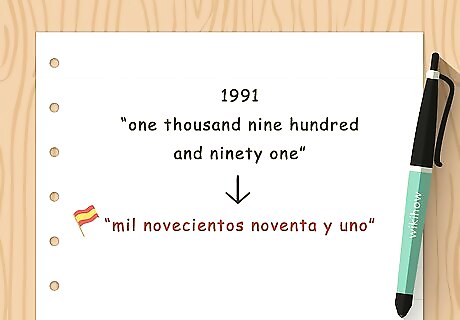
Express the year correctly. In most instances, you probably won't need to state the year along with the date if you're just speaking conversationally. If you do, simply add another de after the month followed by the number that corresponds to the year. In English you may have become accustomed to a shortened way of expressing years. For example, if you want to say 1991 in English, you would say "nineteen ninety-one." However, in Spanish you say the whole number: "mil novecientos noventa y uno," or "one thousand nine hundred and ninety one."
Writing the Date

Use the same "El numéro de mes" formula in writing. Just as when you say the date in Spanish, when you write the date you start with the numeral corresponding to the day, then the month, then the year. Start with "el" for "the," then separate the other parts of the date with the word "de." Just as in speech, there is an exception when you're talking about the first of the month. Use the numeral 1 with a superscripted o that looks similar to a degree symbol when writing the first: 1º. This symbolizes "the first" in Spanish. For example, you could write, "Hoy es 1º de febrero," or "Today is February 1st."
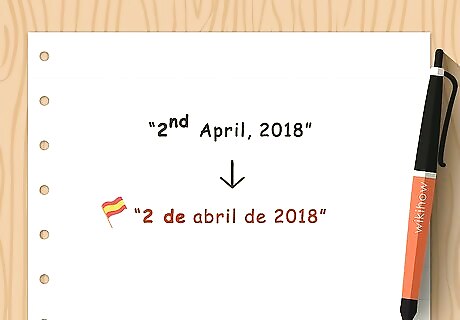
Start with the day. With the exception of the first day of the month, the day typically is written as a numeral in Spanish, not an ordinal number word such as "second" or "third," like you would see in English. You can use numerals ("2") or spell out the number ("dos").
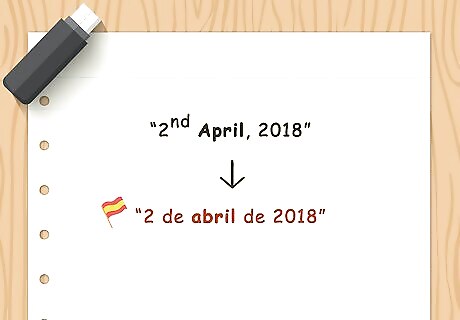
Spell out the month. Follow the numeral that corresponds to the day with the word de. Then write the name of the month. Unlike in English, you don't capitalize the names of months in Spanish. For example, if you were writing about the second of April in Spanish, you would write "2 de abril."
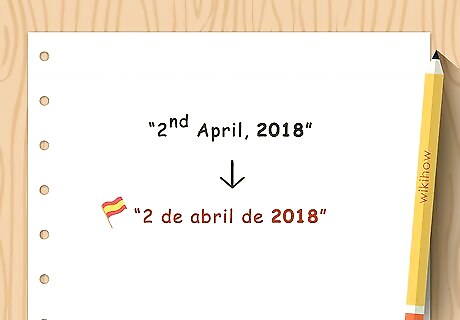
Add the year if necessary. Just as in English, if you're writing the date in Spanish you don't spell out the numbers of the year, you just write it in numerals. Unlike in English, the year is not preceded by a comma. Just as in speech, include the word de between the month and the year. For example, you might write "2 de abril de 2018" for April 2, 2018.
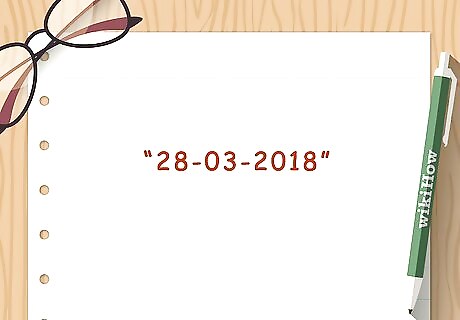
Shorten the date by using all numerals. Just as in English, there is a shortened form of the date that only uses numerals. However, it's still written using the same formula as the long form, with the day first, followed by the month and the year. For example, if you wanted to write the short form of "March 28, 2018" in Spanish, you would write "28-3-2018" or "28-03-2018." You can separate the numbers with dots, dashes, or slashes. Different regions may prefer one form over the others, but Spanish speakers will recognize the date whichever form you choose.
Talking about Time

Ask what the date is. If you want to know the date, use the phrase "¿Cuál es la fecha de hoy?" (coo-AHL ess lah FAY-chah day oy). This question means "What is today's date?" While there are other ways to ask for the same information, this is the most common.
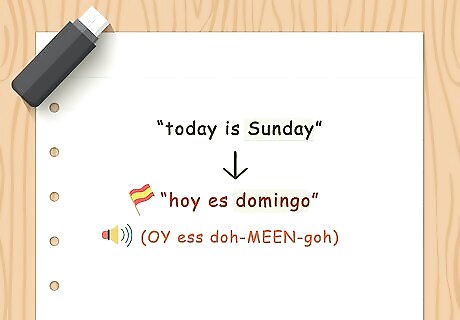
Learn the days of the week. The day of the week can be just as important as the specific date, especially when planning future events. If you learn how to say the date in Spanish, it's also a good idea to know how to say the days of the week in case you're asked. Sunday is domingo (doh-MEEN-goh). Monday is lunes (LOO-nays). Tuesday is martes (MAR-tays). Wednesday is miércoles (mee-AIR-coh-lays). Thursday is jueves (hoo-AY-bays). Friday is viernes (bee-AIR-nays). Saturday is sábado (SAH-bah-doh).
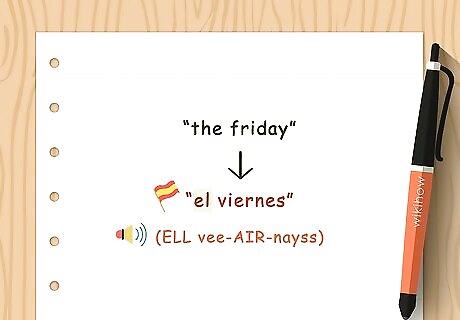
Use el when talking about days or dates. In Spanish, unlike in English, the definite article el (meaning "the") is always used before a date or a word for the day of the week. While you may hear the plural los used, the word el when used with a date or day of the week can be considered singular or plural. For example, if someone asked you in Spanish what your favorite day of the week was, you could reply "el viernes" or "los viernes." This response could be translated either as "Friday" or "Fridays."
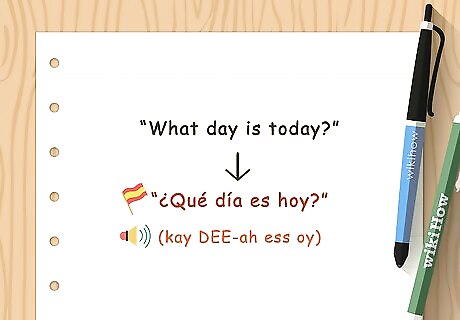
Ask what day of the week it is. If you want to know what day of the week it is, you'll usually ask "¿Qué día es hoy?" (kay DEE-ah ess oy). Be careful with this question, though, because it is sometimes interpreted as asking for the date. You can also drop the hoy from the end and simply ask "¿Qué día es?"

Use the verb hacer (HAH-say) in common time expressions. The verb hacer means "to do" or "to make" in Spanish, but when it is accompanied by "que," it can be used as a time expression. One of the primary uses of this verb in Spanish is talking about actions that happened in the past. Hacer + length of time + que (KAY) + the past tense conjugation of the verb describes an action that occurred at a particular point in time in the past. For example, you might say "Hace tres años que empecé a trabajar aquí" to mean "I started working here three years ago." To talk about a past action that continues into the present, use hacer with the present tense conjugation of the verb. For example, you might say "Hace tres años que trabajo aquí" to mean "I've worked here for three years."
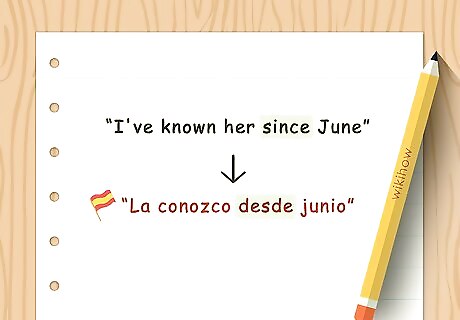
Include the word desde for "since." If you want to say that something has been happening since a particular day or date, put the word desde in front of the date or time, just as you would in English. For example, "La conozco desde junio" means "I've known her since June."
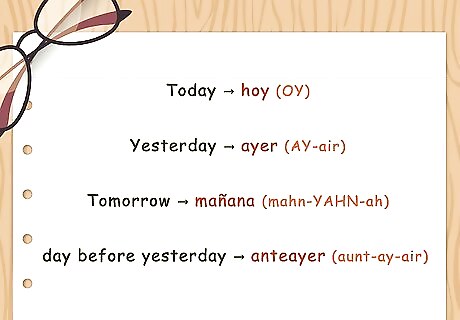
Learn other words to reference time. In normal speech, you don't typically use specific dates all the time to talk about when something is going to happen. Your Spanish will sound more natural if you use relational words such as "tomorrow" or "yesterday." Today is hoy (OY). Yesterday is ayer (AY-air). Tomorrow is mañana (mahn-YAHN-ah). The day before yesterday is anteayer (aunt-ay-air) or "antes de ayer."




















Comments
0 comment